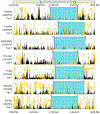Assessment of Circadian Rhythms
- PMID: 31256786
- PMCID: PMC6857846
- DOI: 10.1016/j.ncl.2019.05.001
Assessment of Circadian Rhythms
Abstract
Circadian rhythms are observed in most physiologic functions across a variety of species and are controlled by a master pacemaker in the brain called the suprachiasmatic nucleus. The complex nature of the circadian system and the impact of circadian disruption on sleep, health, and well-being support the need to assess internal circadian timing in the clinical setting. The ability to assess circadian rhythms and the degree of circadian disruption can help in categorizing subtypes or even new circadian rhythm disorders and aid in the clinical management of the these disorders.
Keywords: Circadian rhythm sleep-wake disorders; Circadian rhythms; Core body temperature; Dim light melatonin onset; Rest-activity cycles.
Copyright © 2019 Elsevier Inc. All rights reserved.
Figures








References
Publication types
MeSH terms
Substances
Grants and funding
LinkOut - more resources
Full Text Sources
Other Literature Sources

